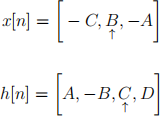10003/10095 Digital Signal Processing
Hello, dear friend, you can consult us at any time if you have any questions, add WeChat: daixieit
Digital Signal Processing
10003/10095
First Assessment
Due Date: 31 March 2024, 23:59
Weight: 20%
Instructions
• Just upload a single pdf document.
• Make sure to answer every question in detail.
• For MATLAB questions, you need to include all the codes and figure plots properly.
• Answer each question separately.
• Add proper comments in your MATLAB code when/where required.
• Handwritten solutions will not be marked.
• Photos taken by phones for manual and MATLAB questions will not be accepted.
• Poor presentation of steps will result in loss of mark.
• Marks shown in blue are allocated for undergraduate students.
• Marks shown in red are allocated for postgraduate students.
Part 1: Manual Questions
Problem 1 (3 Points, 2 Points)
In this question, you need to use digits from your student id. Imagine your student id is 3210487. You will need to use the last 5 digits of your id. 32ABCDE. In this case A=1, B=0, C=4, D=8, and E=7. Having the following discrete signal:
x[n] = (0.AB) n−Cu[n] + (0.DE) nu[n]
In this case we have this discrete signal:
x[n] = (0.10)n−4u[n] + (0.87)nu[n]
in which u[n] represents step function. Now using your own student id number:
1. Determine the DTFT of x[n] shown by X(e jw) (2 Points, 1 Points)
2. Plot the angle, magnitude, real part, and imaginary part of X(e jw) in MATLAB in one window with proper titles and labels. Include your MATLAB code in your answers. (1 Points, 1 Points)
Criterion Point
Each Plot 0.25
Label and Title 0.5
MATLAB Code 0.5
Note: DTFT stands for Discrete-time Fourier Transform.
Problem 2 (4 Points, 2 Points)
Consider the following sequence:
x[n] = (A/1)n (u[n] − u[n − B])
Similar to the previous question, find A and B from your own student ID. If A or B are equal to 0, use C or D instead (u[n] represents step function).
1. Compute the DFT coefficients of x[n] using the DFT definition. (2 Points, 1 Points)
2. Verify your answers using MATLAB. Include your MATLAB code in your answers. (1 Point (0.5 Point) for verification + 1 Point (0.5 Point) for MATLAB code)
Note: DFT stands for Discrete Fourier Transform.
Hint: Try to simplify the sequence first.
Problem 3 (3 Points, 3 Points)
Consider the following sequences (again use A, B, C, and D from your own student id)

are the input and impulse response of an LTI system respectively, that is y[n] = x[n] ∗ h[n].

1. Determine the z-transform of X(z) and H(z). (2 Points, 2 Points)
2. Determine the z-transform of the output Y (z). (1 Point, 1 Point)
Problem 4 (Postgraduate Students Only) (3 Points)
Consider the following sequence x[n]

1. Determine the z-transform of x[n]. (2 Points)
2. Determine the Region of Convergence (ROC) of x[n]. (1 Point)
Hint: Try to plot the sequence first and rewrite x[n] in terms of unit step sequence u[n].
Part 2: MATLAB Question (5 Points)
Problem 5 (5 Points, 5 Points)
Consider the following continuous-time (CT) signal:
x(t) = cos(2πf t)
in which the frequency f of the signal is the last two digits of your student ID multiplied by 10 (for example if your uni ID is 3210487, the frequency will be f = 870Hz).
For your signal, perform the following operations with a proper choice of sampling frequency Fs in order to avoid aliasing (larger than the Nyquist rate).
1. Obtain the discrete-time (DT) version of the CT signal. Plot both the CT signal (for −0.001 ≤ t ≤ 0.001) and the DT signal (for −10 ≤ n ≤ 10). (1 Point)
2. Write a custom MATLAB function to obtain the DTFT of the DT signal. Plot the mag-nitude and angle graphs over −π ≤ ω ≤ π in one figure window. (2 Points)
3. Obtain the fft of the DT signal and plot the magnitude and angle graphs in one figure window. (1 Point)
4. Compare and comment on your observations by comparing the graphs obtained in parts 2 and 3. (1 Point)
Note: For DTFT, you must create your own custom function using the definition of the DTFT.
You cannot use the built-in functions available in MATLAB.
Note: For fft, you may use the built-in function available in MATLAB.
Hint: The format of the DTFT function should be:
function [X] = dtft(x,n,w)
% Computes Discrete-time Fourier Transforms
% [X]=dtft(x,n,w)
% X: DTFT values computed at w frequencies.
% x: finite duration sequence over n
% n: sample position vector
% w: frequency location vector
Part 3: Reflection (5 Points)
Problem 6 (5 Points, 5 Points)
Let’s reflect on what you have learned in lectures, labs, and tutorials for Digital Signal Pro-cessing. In 200-300 words say how have the concepts covered in the tutorials, lab, and lectures enhanced your understanding of digital signal processing principles and their real-world appli-cations? Provide examples of how these concepts can be applied in practical scenarios, such as audio and image processing, telecommunications, medical signal analysis, or any other rel-evant fields.Avoid generalisations and provide detailed examples drawn from at least two to three topics covered in the course. You are highly encouraged to use case studies and do re-search. Remember to properly reference any external sources used (Please only follow IEEE referencing style).
2024-04-04